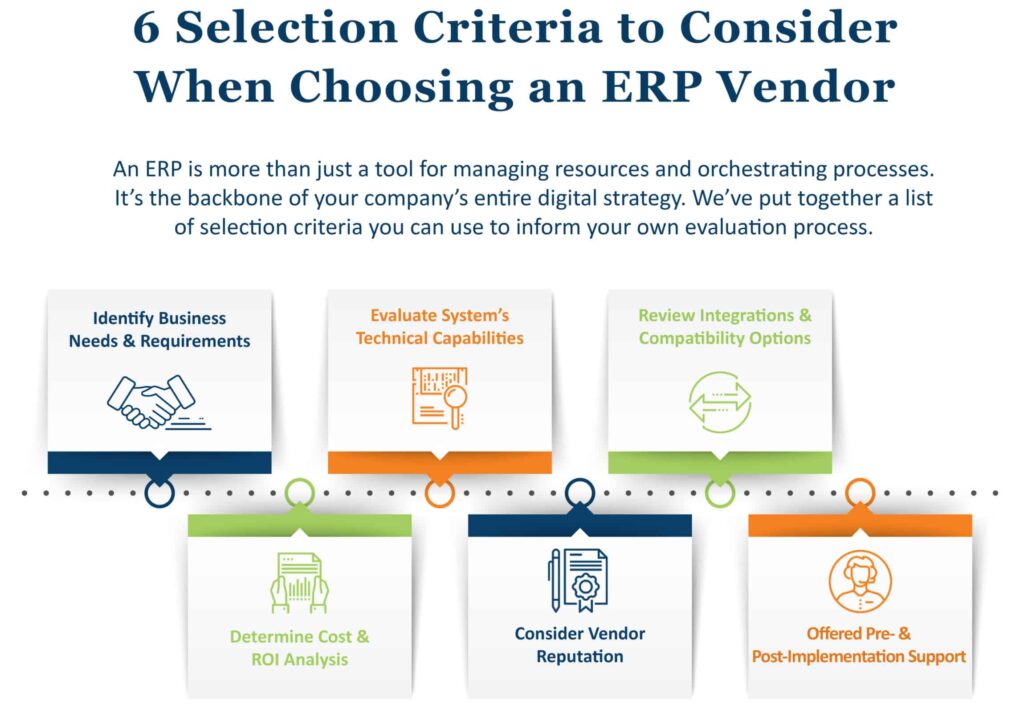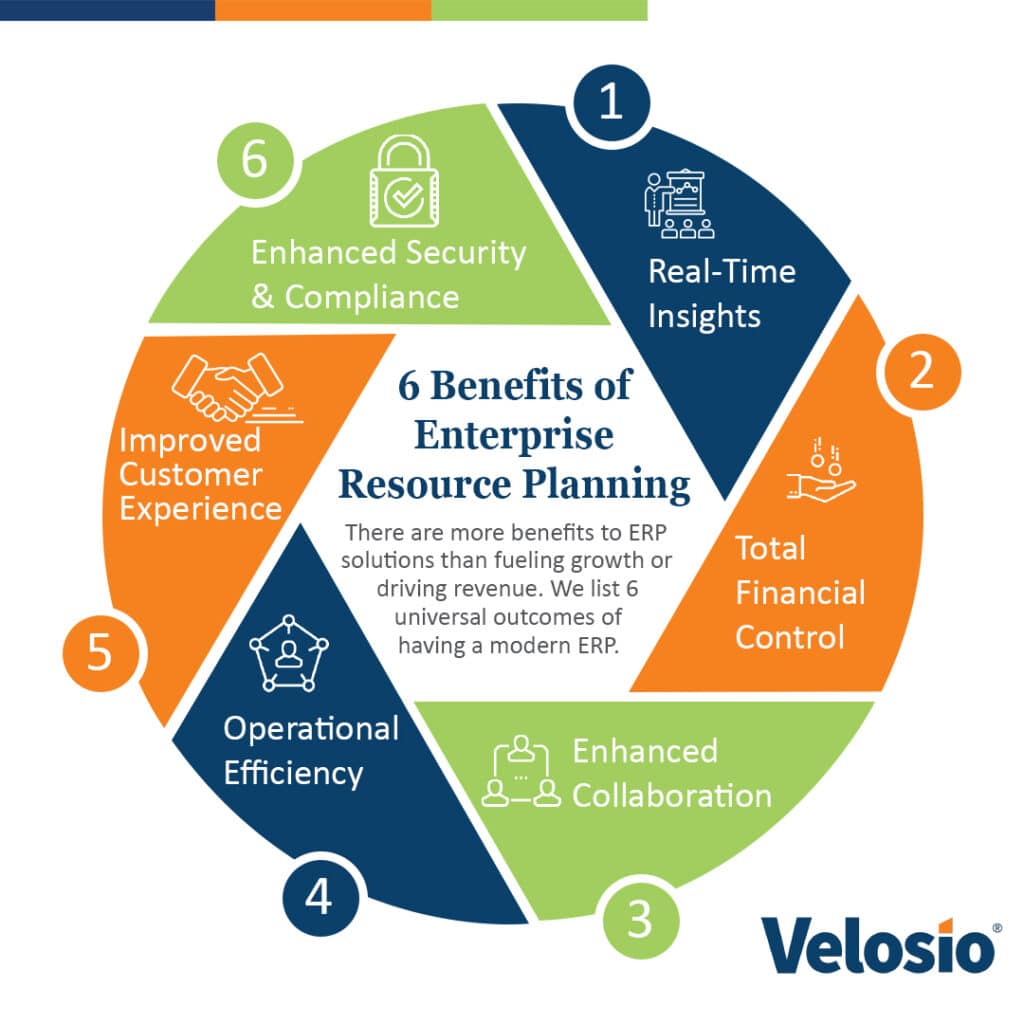A Comprehensive Guide to Choosing an ERP Vendor
We’ve put together a guide to choosing an ERP vendor, with a selection criteria you can use to inform your own evaluation process.
Table of Content
An ERP is more than just a tool for managing resources and orchestrating processes. It’s the backbone of your company’s entire digital strategy.
The problem is, if you don’t know what you’re doing, finding the right ERP vendor amid today’s crowded enterprise tech landscape is about as easy as finding a needle in a haystack.
Fortunately, there are several things you can do to make this process a lot easier. To help you out, we’ve put together a guide to choosing an ERP vendor, with list of selection criteria you can use to inform your own evaluation process.

With a million vendors out there, and even more ERPs, defining and prioritizing requirements early in the game is a critical step toward the right decision – and, eventually, a successful implementation.
So, before you even think about moving forward, you need to figure out exactly what you’re looking for.
Define goals & KPIs. Defining high-level goals (growth, agility, whatever) will help you kick off your search and determine future requirements based on critical objectives. You’ll want to make sure you can answer the following before kicking off your search:
Gather ERP requirements. Next, you’ll want to gather needs/requirements for each department/user group – accounting & finance, sales, HR, etc. Be sure to capture feedback directly from the end-users themselves, and analyze those insights against behavioral/workforce analytics, usage data, and performance outcomes.
Analyze existing processes & workflows. Here, you’re trying to identify gaps & limitations within your current system.
Again, you’ll want to make sure you’re actually talking to the people using these solutions.
Map ERP requirements & build a master list. Mapping business processes and corresponding requirements will ensure you choose an ERP system that not only fits your company’s objectives today but can also evolve to meet your future business goals.
Then, from there, create a master list of requirements – and the people and processes they support. For example:
You might then use this information to build a checklist that organizes insights, features, and functionality by group
This will allow you to build a cohesive system that enables collaboration and knowledge sharing across the entire org. It also helps you avoid redundancies and bloat, which can lead to unnecessary costs and complexity.
ERPs are a big investment. Make sure to thoroughly evaluate the system’s capabilities before making your selection.
Some things you should look for:
Features & functionality. It’s crucial to assess the functionality and features offered by the ERP system. Ask yourself the following questions:
Composability. You want an ERP that will evolve with you – allowing you to move fast, fuel growth, and weather future disruptions with ease. Composable ERPs allow you to swap out individual components, add capabilities as needs change over time.
Scalability. If you’re thinking scalability builds on our last point re: composability, you’re not wrong. Composable solutions are designed to make it easy for users to scale up or down as needed.
But, you’ll still need to be mindful of capacity limits. For example, Microsoft’s SMB solution, Dynamics 365 Business Central uses shared hosting to provide enterprise-grade features at a lower price point.
This isn’t an issue for companies with, say, under 100 employees and modest long-term growth projections. But, if you’re getting close to the “enterprise threshold,” investing in D365 F&O is a better long-term bet.
Other solutions like NetSuite don’t have separate solutions for SMBs and enterprise customers. The benefit is, you don’t have to worry as much about capacity limits. The flip side of this is, smaller orgs might end up spending more on capacity they don’t (and won’t need).
Security & Compliance. Finally, you’ll want to look at what each vendor can do to protect your business from security threats, comply with regulatory requirements, and protect customer data and critical assets. Here you might ask yourself:

It’s important to choose an ERP that checks as many “boxes” on your list straight from the box.
But, inevitably some requirements will be missing,
Every organization is unique and, as such, vendors can’t reasonably accommodate every requirement for every prospective customer. That means, you’ll need to find other options for niche features, one-off capabilities, support for specific legacy apps or custom builds, etc.
Things to look for:
Compatibility with existing solutions. Chances are, you’re not throwing everything out when it’s time for the upgrade. Typically, the migration process happens in phases, and as such, ensuring the ERP will integrate with your existing systems, tools, and data sources is absolutely crucial.
But, it’s important to note that compatibility extends beyond your organization. You’ll also need to think about any partners, suppliers, and external collaborators that may be impacted by this change.
Integrations. Most ERPs support a range of third-party integrations. At minimum, they integrate with popular apps like Shopify, Salesforce, Trello, Google Drive, etc. But, in order to get the full picture, you’ll want to dig deeper. Big name vendors like Microsoft, NetSuite, Acumatica, and SAP all offer niche-specific integrations and ISV solutions specific to their respective platforms.
Customization options. Another thing to consider is how much you can customize/adapt the platform’s out-of-the-box features and functionality. For example:
D365 Finance & Operations, for example, allows you to customize every aspect of the platform. You pick whatever modules, add-ons, and ISV apps you want. Then, you can change whatever elements you need to help end-users reach their goals.
But, for some, D365’s open-endedness feels overwhelming, even risky. So, they might be happier with something like NetSuite that gives them more definitive parameters.
The problem is, if your needs don’t align with the capabilities outlined in the marketing materials, you might end up with several features you don’t need or excessive customizations – which makes things more complex (and costly) really fast.
Another important part of the vendor evaluation process is calculating costs. Now, most vendors (and partners) will tell you that price should not be the determining factor in choosing an ERP.
Yes, it’s important to find a solution that aligns with your org’s financial reality. But, the reason we advise clients not to focus so much on price is because the licensing, storage, and support costs featured on vendor websites don’t represent the full picture.
Instead, try to answer these key questions: what is the total cost of ownership (TCO) for this solution, what kinds of returns can you expect from this investment, how long will it take to actually reap those returns?
According to NetSuite, you can calculate your total cost of ownership with this basic formula: Solution costs + implementation costs + lifetime operating & maintenance costs = TCO
While the formula itself is simple, there are so many different variables you’ll need to consider – number of users, training costs, bundling discounts, storage costs, integrations, legacy apps, and so on.
For ERPs, lifespans tend to range between five and ten years. But – given the rapid rate of change, you’ll likely be investing in smaller upgrades more often.
Consider factors that might influence maintenance costs, extra fees, and future investments. These might include:
To calculate ROI you can use this formula: (total value of investment – TCO) / TCO) x 100
The higher the ratio, the bigger the return. But, you’ll need to perform a detailed analysis of all costs, benefits, and impacts across all ERP objectives.
Again, you’re dealing with a lot of variables you may not be able to quantify at this point, so you’ll probably want to leave some room in your budget for unexpected costs.
Vendor reputations can help you avoid shady contracts, low-quality solutions, and full-on ERP scammers. They’re also an important tool for finding the ideal solution.
You’ll want to do some research before reaching out to vendors (and, inevitably, getting trapped in their sales funnels) that may be a bad fit.
Look at things like:
Testimonials, industry awards, and customer case studies – these items indicate that vendors are legit – with a history of delivering on the outcomes that were promised.
Industry experience. You can usually find customer stories on vendor websites to get a better sense of what industries and use cases they support. If you’re looking at niche ERPs like, say, SYSPRO or Acumatica, looking at client rosters can help you figure out whether solutions align with your requirements.
ERP systems that cater to a broader audience like Microsoft Dynamics 365 or NetSuite ERP it’s not as important to find a customer story just like your own. Solutions can be adapted to the needs of almost any business. So here, it’s more about the vendor’s ability to support higher-level goals – process efficiency,
Existing partnerships. Strong partnerships with other companies are not only a sign of good character, they’re indicative of a broader network you can tap for additional resources, solutions, and support for maximizing the value of your ERP.
Interview short-listed vendors. Once you’ve eliminated the last remaining “bad-fit” vendors from your list, you’ll want to reach out to the ones that made the cut.
Here are some specific questions you might ask to help narrow your search.
You’ll also want to pay attention to “softer” factors like communication styles, availability, and whether providers were proactive about asking questions, providing resources and sharing potential solutions.
A strong support system is essential for a smooth ERP implementation and long-term success.
Naturally, that means you’ll want to look at the level of customer service and support that each vendor (or the partners in its network) can provide. Start by focusing on these key areas:
Available services & support structure. Most vendors offer basic support with each license – updates, bug fixes, and help troubleshooting technical issues or resolving support tickets.
If a vendor doesn’t offer the level of support you’re looking for, they might not be a fit.
Partner networks. Partner networks are often a better bet than paying for direct support from the vendor. Microsoft, for example, has a robust partner network that includes providers offering specialized IT, consulting, development, maintenance, and other services that support ERP selection, implementation, and training.
Many partners (Velosio included) also offer long-term support, optimization, and custom solutions that can help you maximize the value of your D365 investment.
If your vendor doesn’t have a very robust network, or you can’t find a partner that aligns with your needs, you’ll be better off with a vendor with more resources.
Choosing an ERP vendor is a critical decision for any org. It has a tremendous impact on all business operations and processes. It’s important to carefully evaluate your options before making a final decision.
Velosio offers tailored ERP solutions and advisory services that help clients transform their business with targeted expertise, ecosystem strategies, and technologies like advanced analytics, embedded AI, and automation.
While our ERP practice is limited to Microsoft and NetSuite products, our experts are here to answer questions and provide guidance. Even if it means pointing you in a different direction. Let Velosio be your guide to choosing an ERP vendor.
Talk to us about how Velosio can help you realize business value faster with end-to-end solutions and cloud services.
"*" indicates required fields